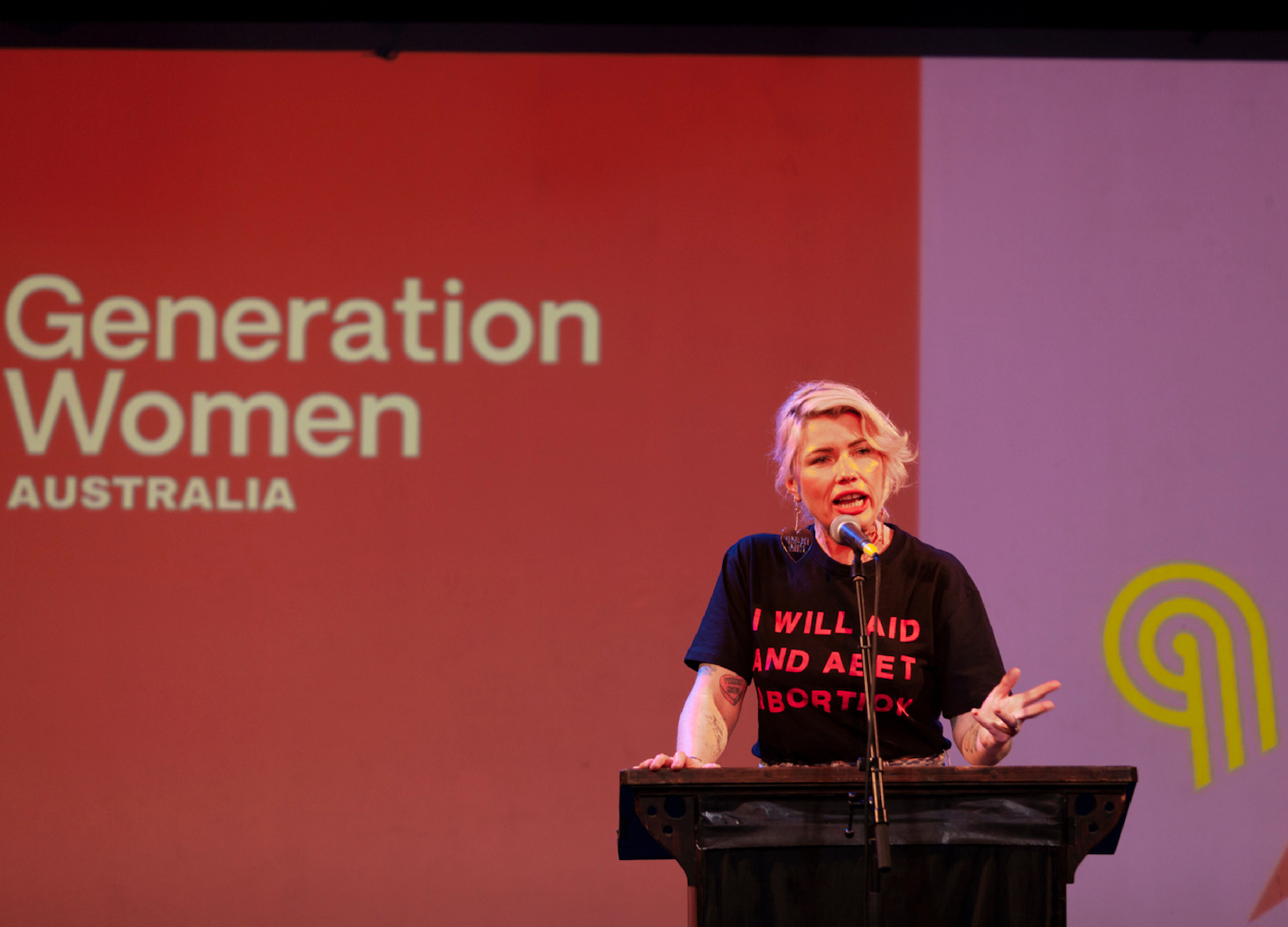
“Seize This Moment”: Women from 20 to 70 Share Stories of Revolution
Generation Women Australia is a multigenerational storytelling night held in Sydney and Melbourne. Founded by Georgia Clark, who was moved by conversations with her mother about the feeling of disappearing as an older woman, the monthly event offers a warm and inclusive space where people of all ages can come together to share, celebrate and learn. The shows aim to amplify a selection of female and non-binary voices – representing those in their twenties through to their seventies – each sharing their own stories on a specific theme.
In response to the overturning of Roe versus Wade in America, the theme for November’s event was “Revolution”, with performers including Clementine Ford, Jane Caro AM and Virginia Haussegger AM. Here, with thanks to the team at Generation Women, we’ve published the stories of six incredible women from the event. May they “reignite your ambition to think boldly and install hope”.
For more information about Generation Women, including forthcoming events in February, head to their website here.
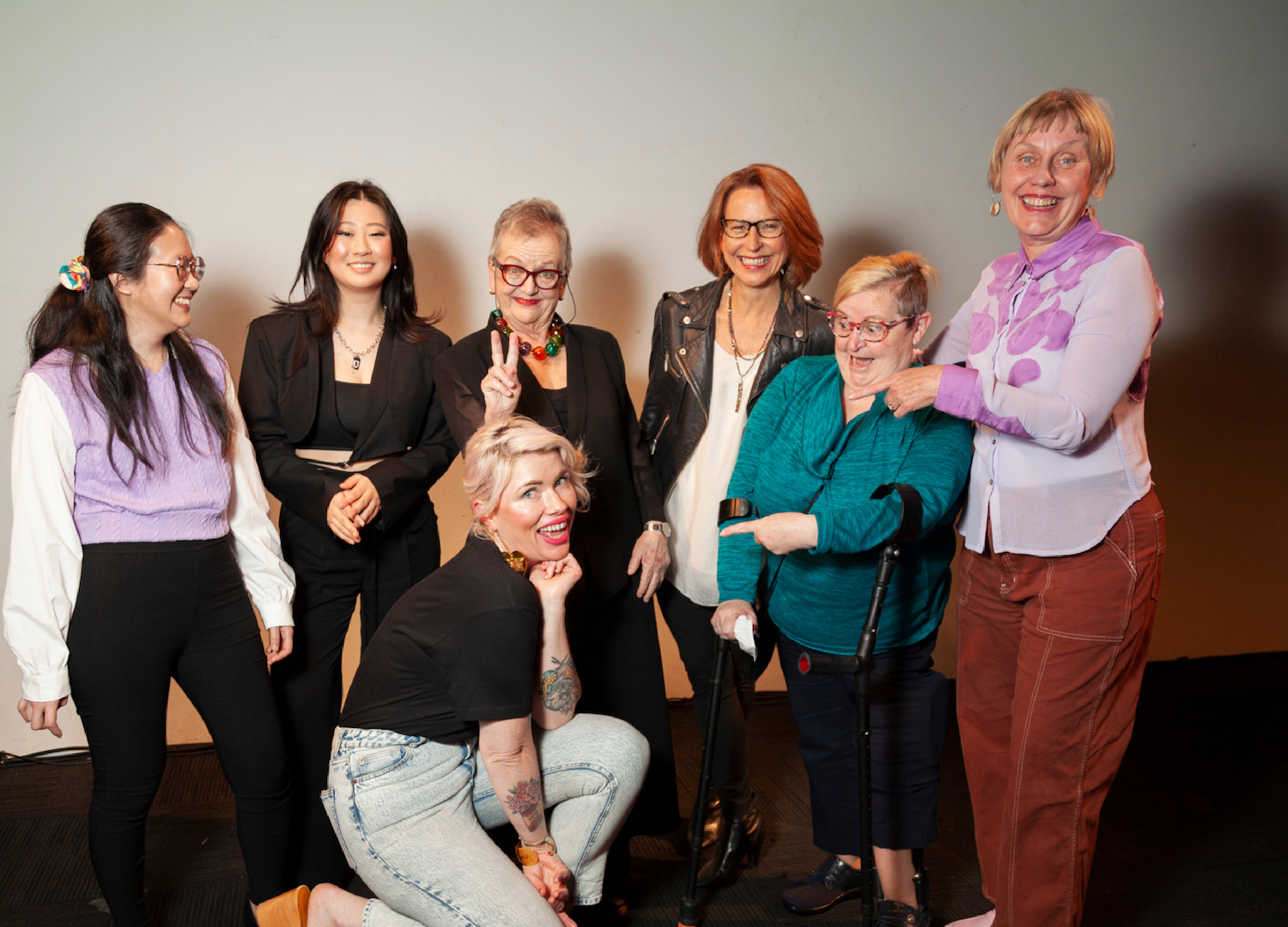
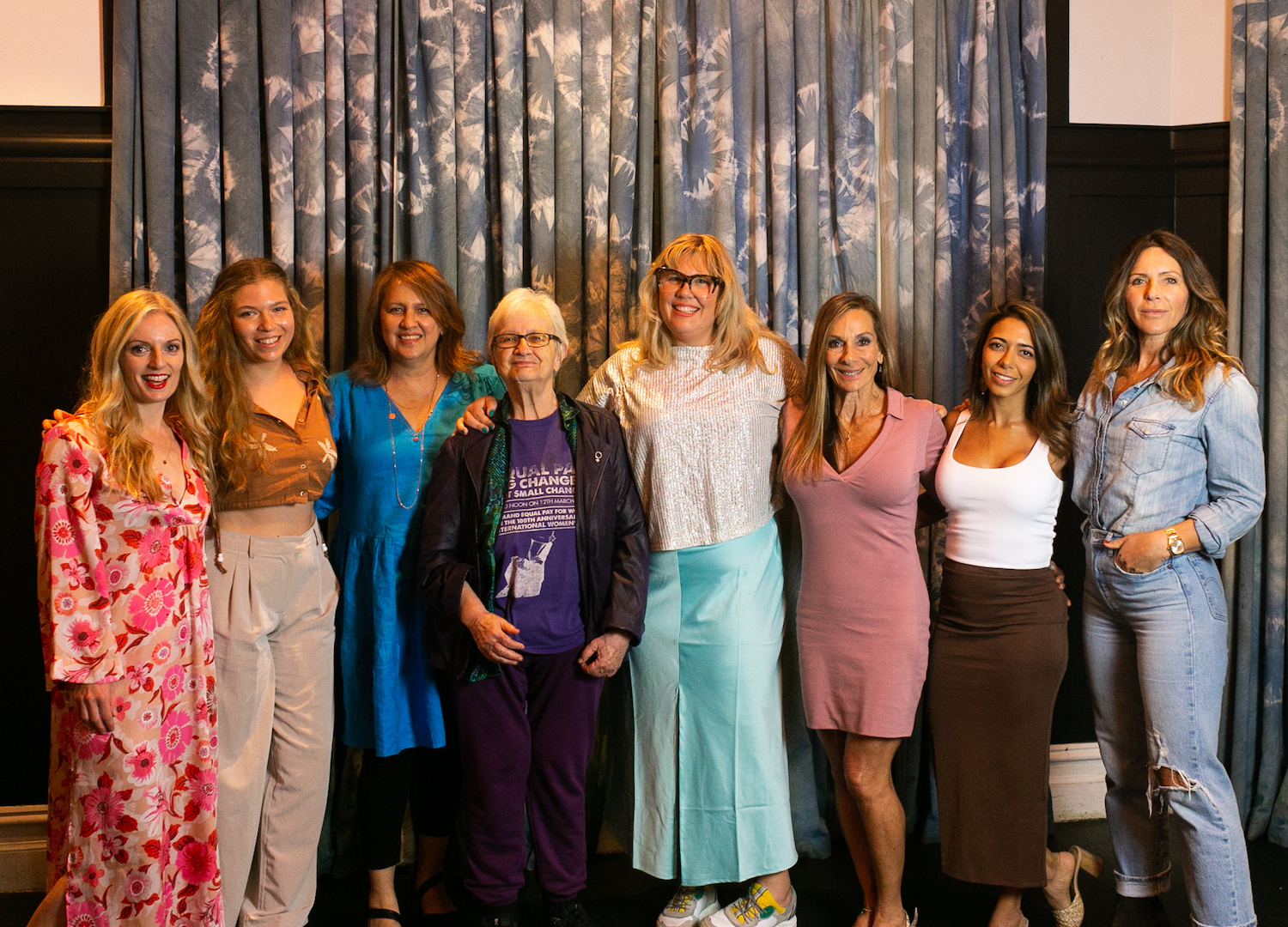
top GENERATION WOMEN MELBOURNE: REVOLUTION! SPEAKERS. PHOTO BY SEVIM DOGAN OZKAN. bottom GENERATION WOMEN SYDNEY: REVOLUTION! SPEAKERS. PHOTO BY TENIOLA KOMOLAFE.
Melbourne Storyteller Team 20s: Jun Kim
Sydney Storyteller Team 30s: Martha Gouniai
Melbourne Storyteller Team 40s: Clementine Ford
Melbourne Storyteller Team 50s: Virginia Haussegger AM
Sydney Storyteller Team 60s: Jane Caro AM
Melbourne Storyteller Team 70s: Moira Rayner
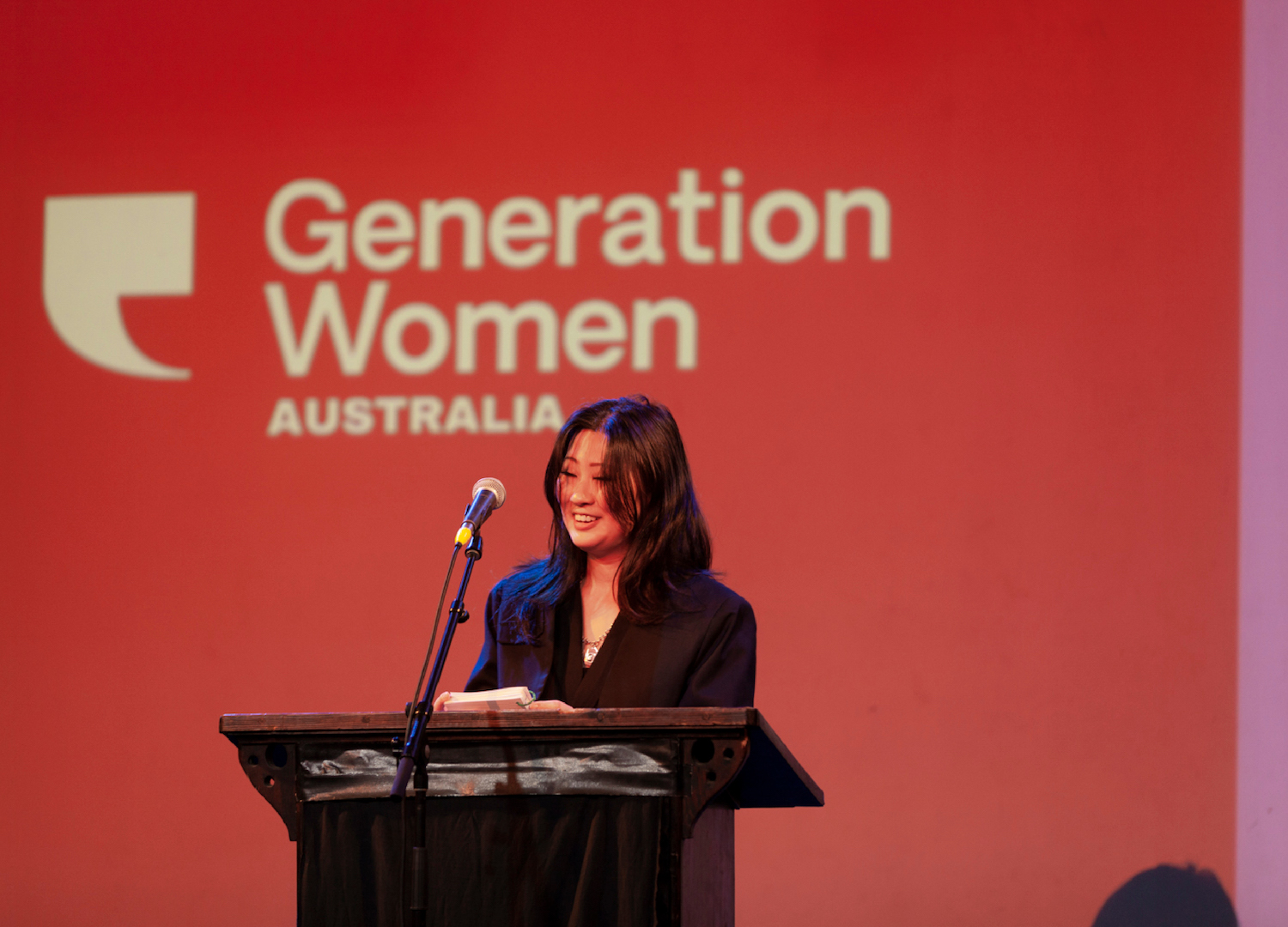
above JUN KIM SPEAKING AT GENERATION WOMEN MELBOURNE: REVOLUTION! PHOTO BY SEVIM DOGAN OZKAN.
Melbourne Storyteller Team 20s: Jun Kim
I’ve always wanted to write. As a kid, my dream was to be a writer. I would spend any free time that I had as a child filling up my notebook with words. As I grew up, I graduated from writing acrostic poems and stories about fairies to writing long-winded essays on the horrors of colonialism and WAP, aka, White Australia Policy. I didn’t know what exactly I would write about when I’d turn it into a career, but I knew it would centre around my experience of being a Korean woman living in Australia. That, I was certain about…
Despite topping both my English and Literature classes in high school, I often asked myself: how can I compete with people who have only spoken English their entire lives, have white-sounding names and are white? So, I repressed my desire to turn writing into a career. I did what every dutiful Asian kid was supposed to do: I gaslit myself every time I caught myself dreaming of a career in humanities, and got accepted into a Bachelor’s of Biomedicine at Melbourne University. My parents rejoiced at the fact that their hard work had paid off, and paraded me around to literally everyone who would give them the time of day – I’m talking friends, friends of friends, families of friends and even their dogs. Every time they did this, the guilt and shame of desiring a career in writing ate away at my soul.
This dream of becoming a writer was something that I’d been holding onto for years – it was a secret I’d kept from my parents in fear of the incessant guilt-tripping, yelling and beatings they would inflict upon me for straying off the pathway they had painstakingly carved out for me. I kept telling myself: I can still write essays and novels on the side when I become a doctor. I can have it both ways. But I soon realised that I hated studying medicine. Honestly? I wanted to like it. But it just wasn’t me. I could not give one single damn about the function of the large intestine or the names of amino acids. I couldn’t visualise myself standing in a white coat, getting spattered with blood and pus on the daily. This wasn’t how I wanted to enact change in the world.
It’s about connecting the dots – I’m legitimising my experiences by linking them to historical, political and social factors which are common to people of colour.
And so, after four years of stretching out my course until its last breath, failing subjects and having one too many mental breakdowns, I begged and bartered with my parents about changing courses. My parents finally agreed to this under the caveat that I would get a PhD in my chosen field, Asian Studies so that I’d still be a doctor even if it wasn’t in medicine. I haven’t looked back since.
What drew me to Asian Studies, though, is not just because I’m Asian. It was largely to do with the frustration of seeing white academics, time and time again, tell me what THEIR interpretation of the Asian experience was. It was to do with the misrepresentation of Asians, and by extension, my lived experience, by publications that would colour the perceptions of non-Asian people on the Asian experience. Basically, becoming an academic was my way of telling my story, and contributing to the prevailing discourse.
One day, I’ll write a series of short stories or a novel about my experiences. I’ll keep my promise to five-year-old Jun who stood in front of her Grade 1 class and proudly stated that her dream was to become a writer. But, for now, writing theses and doing research is about turning my lived experience into something that is officially recognised in an academic context. It’s about connecting the dots – I’m legitimising my experiences by linking them to historical, political and social factors which are common to people of colour. It’s about contributing to the existing discourse on Asia, in English, from my subject position of an Asian woman living in Australia.
It’s about setting the record straight.
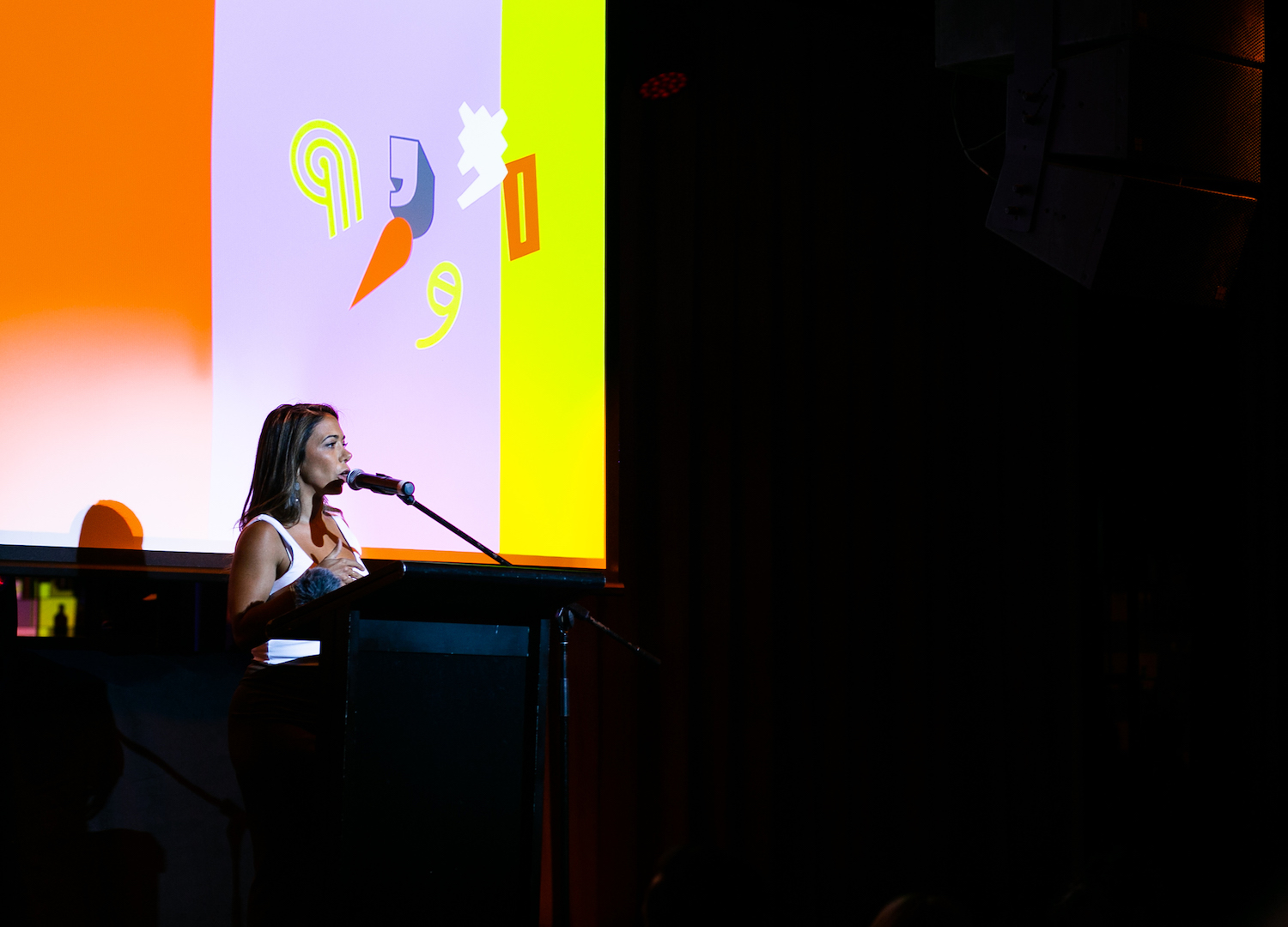
above MARTHA GOUNIAI SPEAKING AT GENERATION WOMEN SYDNEY: REVOLUTION! PHOTO BY TENIOLA KOMOLAFE.
Sydney Storyteller Team 30s: Martha Gouniai
I’m not a drinker but I’ve always been fascinated by Shiraz wine. Especially the idea of an Australian Shiraz.
Because Shiraz is actually pronounced ‘Shi-raz’ and it isn’t a wine or a type of grape, it’s a city. A beautiful city in Iran. The city my grandmother is from.
I guess I always hoped to be like an Australian Shiraz, my origins deeply rooted elsewhere but so accepted as being from here that no one would ever think to question it. When people look at me, they don’t guess my heritage is Iranian or Persian. Usually, I get South American, mostly Brazilian, sometimes Italian or Greek. I’m brown, I live in Bondi – I must be Brazilian!
There was a time in my life when I relished this. I loved being ambiguous enough that I could be from anywhere, anywhere that was socially acceptable, anywhere that people were familiar enough with, anywhere but Iran.
I remember a day in primary school, I must have been six. We were learning about groupings and graphs. We grouped and created graphs for the number of kids in the class that liked dogs and those that liked cats and rabbits. Then we did groupings by hair colour.
“Raise your hand if you have blonde hair,” and a bunch of kids raised their hands. “Raise your hand if you have brown hair,” and I along with an even bigger group of kids raised our hands. I remember looking around me and feeling pride, this was my group. I was a brown hair kid with all my other brown hair people. I belonged.
Until a boy sitting on the floor behind me pointed at me and exclaimed, “You don’t have brown hair, you have black hair.” I was mortified. What an accusation. “I have brown hair,” I yelled back in defence, “It’s dark brown.”
“No, you don’t, you have black hair like them,” and he pointed at the only two people in the class with black hair.
I looked over at these two black hair girls and recoiled. I didn’t want to be grouped with them, with the quiet minority. I wanted to be in the brown hair group with everyone else.
Eventually, the teacher split the brown hair row with a line and added the title ‘Dark Brown’ and next to it she wrote my name… alone.
“Raise your hand if you have black hair,” and the two girls raised their hands.
I looked at the hair colour groupings chart and realised that in my desperation to belong with the masses, I made it certain that I belonged with no one. I had rejected the group I could have been with and the group I wanted to be with rejected me.
Then high school came and with that September 11. I went from being the “foreign or ethnic” girl to being a “terrorist”.
I resented the things that made me different, that kept me outside the majority. My unpronounceable surname; my thick dark hair that hairdressers all struggled with; the hair that grew on my body that gave me the nickname ‘Hairy Arms’ by enough of the boys; the weird food my parents cooked that was too hard to explain to my friends; my strange religion that no one had heard of.
I didn’t want it, I didn’t ask for it and I rejected it.
When at the beach I covered myself from the sun so I wouldn’t get too brown; I bought foundation that was way too light.
I wasn’t interested in connecting to a country that made refugees of my parents and kept us separate from our family. I didn’t care about a culture and language that was associated with bombs and asylum seekers rejected by this country.
When people thought I was Brazilian or Columbian or Spanish, it was a relief and I took on the identity of a person of the world. I imagined that my heritage was diverse and unknown. After thousands of years of empires invading one another across ancient Persia, I was bound to be a mix of many different ethnicities. Maybe some Mongolian or Roman or Greek or Turkish or Russian. I just knew it and believed it to be true.
So when I did a DNA test and the results arrived I was ready to be validated. What exciting mix of cultures and ethnicities would I be?
98%… 98% Persian.
I was devastated. How could this be? How could anyone be so bland, so confined? 98% Persian? And there was a map with an outline of Iran and it was all shaded in just to add to the mockery of it all.
My made-up identity was shattered. I didn’t know who I was. There was a hollow within me that I had been ignoring, filling up with other identities as I spent my life rejecting my own.
Today I know who I am, I know the land that I am connected to and the generations of women and men whose stories run through me.
On 13 September 2022, 22-year-old Mahsa Jina Amini was arrested in Iran by the morality police for incorrectly wearing her hijab. She died in custody three days later with signs of torture and beatings across her body.
Her funeral sparked protests demanding equality for women – those protests have become a movement spread across the world. In Iran today, women and girls are defining bravery and courage, marching in the streets without their hijabs, accompanied by men and boys chanting the slogan of the movement “Zan, Zendegi, Azadi” (“Women, Life, Freedom”). In the face of bullets, mass arrests, beatings and executions they are defiant. United in their fight for equality, for freedom.
My 98% is made of fire.
Today I know who I am, I know the land that I am connected to and the generations of women and men whose stories run through me. Táhirih, an eighteenth-century poetess and heroine of the Baha’i Faith, is quoted as saying before her own execution, “You can kill me as soon as you like but you will never stop the emancipation of women.” Mona was just 17 years old when she was executed by hanging for refusing to deny her belief in the Baha’i Faith. Ideh, my mother who was forced from her home, from her family, when she was just 18 years old, built a new life for herself and for her family here in Australia.
I come from bravery, justice and sacrifice.
I am a woman from Iran.
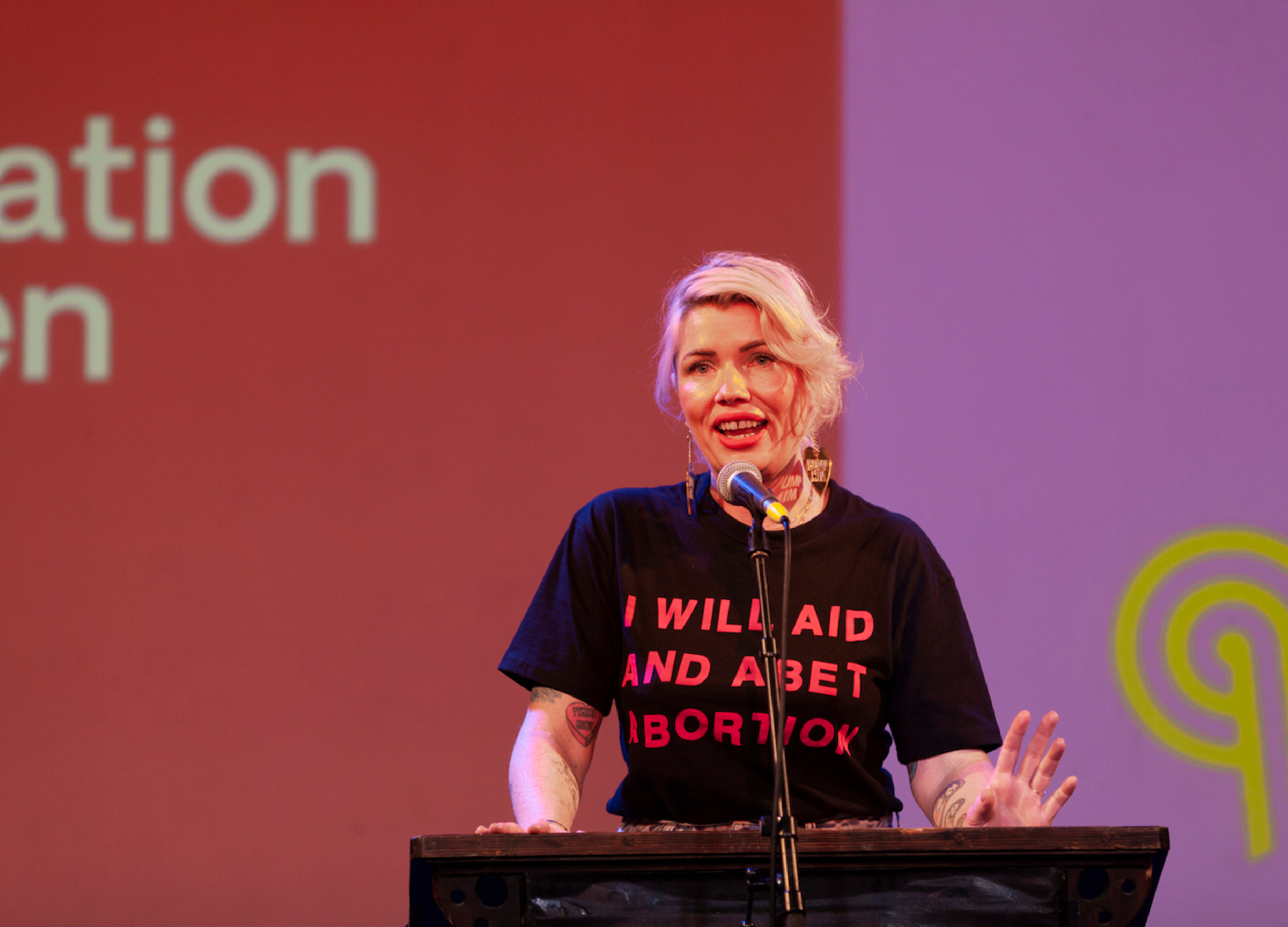
above CLEMENTINE FORD SPEAKING AT GENERATION WOMEN MELBOURNE: REVOLUTION! PHOTO BY SEVIM DOGAN OZKAN.
Melbourne Storyteller Team 40s: Clementine Ford
Generation Women is explicitly a storytelling night, however, in response to the overturning of Roe versus Wade in America, Clementine Ford gave a speech during this special themed show. This speech is part of Clementine Ford’s forthcoming book ‘I Don’t’ – out October 2023 through Allen & Unwin.
The writer and philosopher Kate Manne has likened the use of misogyny to shock collars worn by dogs to train them to stay behind invisible fences. While misogyny can and indeed does inflict terrible violence, Kate argues that the threat of it can often be enough to “discourage girls and women from venturing out of bounds”.
We know what happens to the women who do. The spinsters, misandrists, shrews, demon spawn from hell encased in human skin suits – no matter what euphemism our unrelentingly misogynistic society has coined to describe women who consciously challenge patriarchy, the underlying message from the outside world is always the same: we don’t trust you, WITCH.
But it’s to the witches, friends, that we need to look for the reason why modern women – who supposedly are more blessed than ever, with more access to equality and opportunity than ever – have internalised the idea that we are each other’s worst enemies. That there is danger in solidarity with one another, that we must work alongside patriarchy to be spared by it, rather than risk what happens when we challenge it. No matter what we do in our day-to-day lives, we cannot have the revolution we need unless we understand the violence that we have come from.
They killed us, you know – the witches I mean – deliberately, brutally and in a sustained fashion. More than 40,000 of us, over almost two hundred years. Most witches were women… obviously. I mean… everyone knows that! We know it because we’ve been told it, right? It just makes sense. You’ll be familiar with King James I – you’ve probably found one of his bibles in a motel drawer at some point. But King Jim also wrote a book called Deamonologie, in which he argued that women were in fact 20 times more likely than men to be witches. The reason for this was threefold: firstly, that women were more curious than men; secondly, that our thirst for revenge outstripped theirs; and thirdly, that we had a “greedy appetite caused through great poverty”.
To be honest, all of that sounds quite accurate to me. But somehow, I don’t think King Jim considered it a compliment to call us both curious and diabolical, or necessary to reflect on why “great poverty” might encourage our ambitions. What he did do was use it to justify the murder of thousands of Scottish women who had been accused of witchcraft, which makes the casual endorsement of his bible in accommodation services across the globe especially grotesque.
Now, I’m not telling you to throw the King James Bible in the incinerator whenever you find one – but I’m not not telling you that either.
King James was just one patriarchal leader who advocated for the murder of women as witches. The Malleus Maleficarum also known as the Hammer of Witches, was published in 1486 and considered for more than TWO CENTURIES by the church to be the definitive guide to witch hunting. And it wasn’t just any old woman who was targeted. It was the wise women. The medicine women. The midwives. The Malleus dedicates an entire chapter to midwives, calling them “the worst of all women”, for they had access to life and death – and with no men around to oversee the operation, how could they be trusted to not be delivering babies to Satan? The midwives and the wise women didn’t just oversee birth – they also provided herbal forms of contraception and abortion, giving power to those with reproductive capacity to determine how, when and even if they bore pregnancies. Too much power, and none of it held by the state!
The persecution of witches decimated millennia worth of knowledge; by the beginning of the eighteenth century, obstetrics was mostly overseen by men – and for most of our lifetimes, it has just been accepted that pregnancy and childbirth is the realm of a medical fraternity mostly dictated by people who will never experience either.
How dare they!
But how did we fall for it?
Because they taught us, most of all, to fear each other.
Women exist and thrive regardless of whether or not a man is there to witness us in motion. We are in motion. We always have been. And the motion we are caught in now is the one that helps us find our way back to each other.
The trials and resulting executions of “witches” worked to distance women from one another – because even connection between women was enough to cause suspicion that we may be colluding with the Devil. Women who were accused (and horrifically tortured) were sometimes compelled to accuse other women in the hopes of sparing their own lives. This fear of each other continues today. We can see it in the behaviour of Pick-Me Girls and their appeal to male authority and approval. “I’m not like other girls, I just get on better with men, women are too bitchy/mean/vindictive, you never have to fear that I’m on their side, I’m not I’m not I’m not.”
We can see it too in men’s inherited suspicion that women might be colluding against them – because when two or more women spend time together without men to oversee the proceedings it isn’t a gathering, it’s a coven. According to Silvia Federici, the word “gossip” in the Middle Ages had once simply meant “friend”. But because friendship between women (who were untrustworthy, vindictive and slippery-tongued) was a source of suspicion, “gossip” took on the meaning that we understand it to have now – to wit, that it’s something meddlesome women do with the intention of causing damage to innocent people.
The Malleus had warned of the capacity of witches to destroy men, drawing them in with the allure of beauty and the scent of sex and then castrating them for laughs (or, as one witch was referred to as doing, hiding dozens of their penises in a tree). This suspicion of women’s motives didn’t disappear alongside the diminishing spectre of witches and has only managed to become more robust in the intervening centuries.
Imagine if the worst of COVID had lasted for over a century. If people had been criminalised for touching each other, hugging, seeing each other outside of curfew – not just for five months or even five years, but for 500 years. Imagine if, for just over a quarter of that time, the people who committed the grave crime of touching, hugging, seeing each other, were tortured into confessions. Forced to turn on their neighbour. Burned at the stake, hanged at the gallows. Their children made to watch.
Imagine how different our culture would be. How normal we would think it to avoid touch, to spurn hugs, to report on our neighbour for seeing other people? Imagine the terror we would carry in our cells for the idea of doing any of this, but more importantly how frightened we would be at the idea of being caught or even suspected of such a thing? We are a naturally tactile species – but could our nature be bred out of us, or at least imbued with such deep paranoia that we would learn to associate even the thought of these things with torture, executions, murder?
This is what has been done to women. We carry the legacy of fear in our cells, the implicit understanding that too much solidarity with one another WILL lead to a finger being pointed in our direction.
“WE DON’T FUCKING TRUST YOU, WITCH.”
This is how modern patriarchy keeps the supposedly empowered woman from overthrowing it. By first using a shock collar to train us to fear it, and then making itself invisible to make us believe it’s our choice.
It doesn’t have to be like this.
We have been conditioned to devote ourselves to men rather than each other. To prove that we aren’t a threat, that we deserve to be spared. But the only way we will defeat the system and restore our essence is through women working together. Because if you think men – as a class of people – have your back, I’m sorry to tell you you’re wrong. Men will NEVER go to the mat to defend women the way that women consistently turn out to pledge their allegiance to men.
Male supremacy cannot survive women’s solidarity. Fact. But women’s solidarity is also not always about men. In fact, sometimes – most times, in fact – it’s nothing to do with men at all. That’s another lie the patriarchy wants you to believe – that everything women do and think and say and breathe is somehow motivated by men’s opinions. Women exist and thrive regardless of whether or not a man is there to witness us in motion. We are in motion. We always have been. And the motion we are caught in now is the one that helps us find our way back to each other.
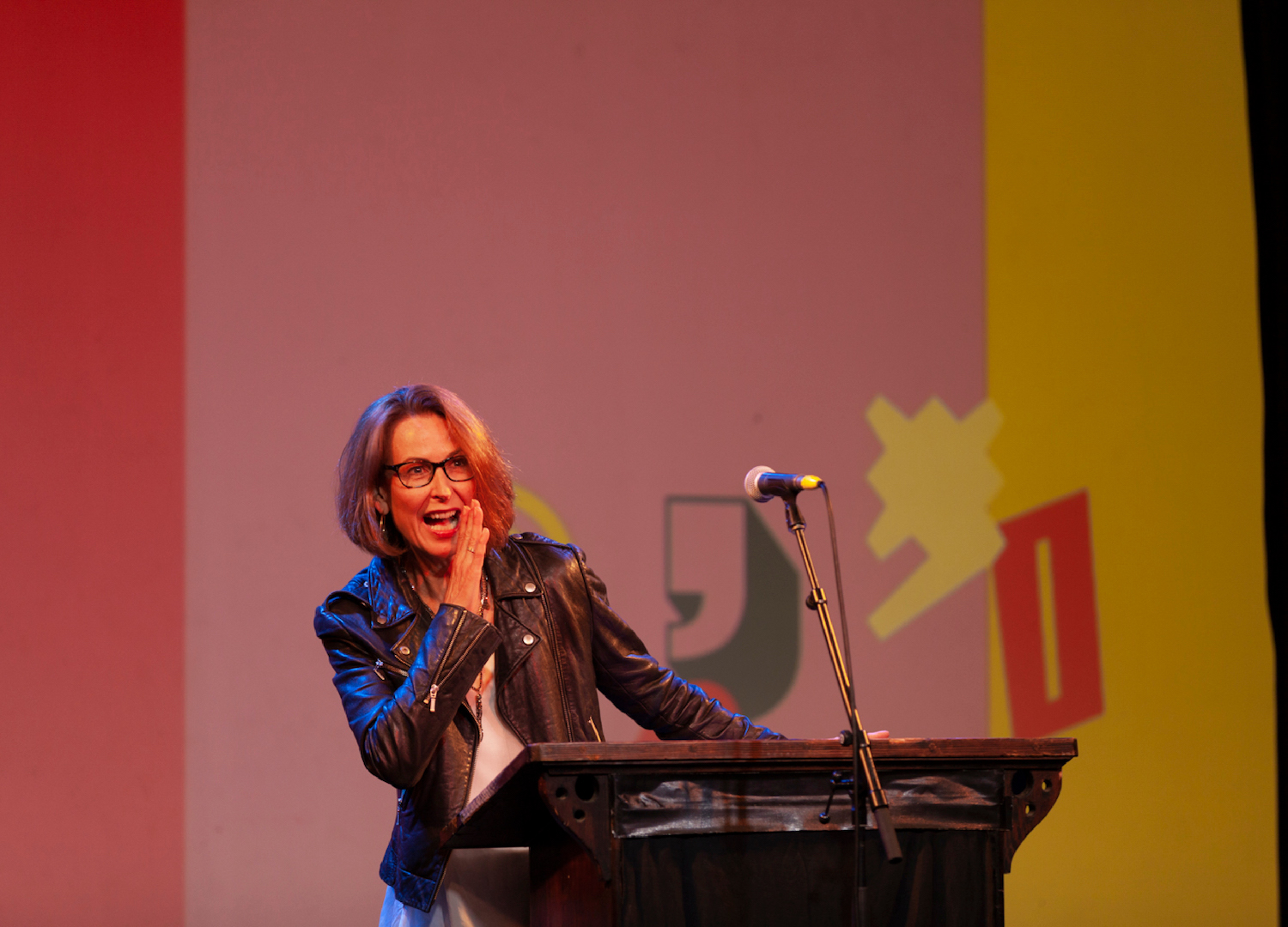
above VIRGINIA HAUSSEGGER AM SPEAKING AT GENERATION WOMEN MELBOURNE: REVOLUTION! PHOTO BY SEVIM DOGAN OZKAN.
Melbourne Storyteller Team 50s: Virginia Haussegger AM
Oh, what a beautiful thing… to be Ms 50-something. I never thought I’d reach the grown-up age of 50-plus. But here I am. And damn grateful for it.
Turning 50 was one of the best years of my life! At 50, finally, it was time to rip off the “imposter syndrome” suit and parade rip-roaring naked as I am.
Some years ago, back in the 1980s, here in Melbourne, when I was a shiny new cadet journalist at ABC TV News, I was out drinking with my colleagues when my drunken boss leapt off his chair, waving his arms around like Dr Smith’s robot, “Warning, warning,” and bellowed at the top of his voice, for the whole bar to hear, “You’re un-natural… that’s unnatural!!”
I’d been in the job for less than six months, but already I could see how the system worked.
If I really wanted to chase my ambition and become a globe-trotting foreign correspondent, I’d have to ditch any idea of having children. There was not one single female foreign correspondent in any Australian news outlet at the time. I absorbed that reality. I got the message. Clearly, kids were a career impediment.
So in that noisy bar, I had just boldly proclaimed to my boss that I never wanted to have children. I was 22 at the time.
I also said I didn’t want to live beyond 30 as I couldn’t see the point. Secretly, I assumed I’d achieve everything I wanted to do by the age of 27 and then cruise for a bit.
What my vodka-breathing boss should have said, rather than suggest I was some kind of “un-natural” female deviation, a ‘feminine deformity’ was, “Virginia, best to keep an open mind as you may change and the world may change with you.”
I did change but the world did not change with me. Not enough.
Yes, there has been an incremental change in the numbers. Gosh, women are everywhere now… mothers included! Even in our House of Representatives, over a third of those seats are held by women. For a long while, I was a big counter of numbers. Always counting the percentage of women in any list, in any forum. Until I woke up to the problem.
It’s not about the numbers. It’s not the count – it’s the culture!
What more punishing prompts do we need to wake the sleeping bear? To hear her roar? We have done reform. Now it is time for revolution!
On Monday I heard an ABC journalist proclaim, “Equality has never been closer – we’ve long been told.” You know, the fascinating thing about a lie is that the more we tell it, the deeper we root it in our psyche as real. We repeat it so often that soon it becomes our agreed reality. Immutable fact.
At that point, we are doomed. And here we are.
Back in 2019, I had the tremendous honour of being named ACT Australian of the Year. I was referred to as the “feminist advocate”, the “gender equity activist”.
In the lead-up to the ceremony, I attended a VIP lunch at Old Parliament House and was sat next to a senior cabinet minister and his wife. Visibly disinterested in me or the issues I was discussing, the minister sat looking glum while his wife did the talking for him. When she heard I was the director of a research foundation focused on increasing the participation of women in public leadership, she slapped the table with glee, as if pressing a game show buzzer.
“Oh, well of course women are everywhere now!” She beamed as if she’d just zapped me off the show and out of a job. “I mean, it’s totally changed. Everything has totally changed for women.”
She then leaned into the table, saying, “And we need to thank the men who have allowed us to do all this. Who have allowed women to work and have ambition.”
At that moment I started to choke on my bread roll. Kamahl leapt up on stage and began singing. It was surreal!
The lies we tell ourselves about gender equality and women’s progress are gobsmacking. Shockingly bold in their assuredness and outrageously untrue. Worst of all, those lies are weaponised against women. Used to shut us up and shut us down.
Around Australia, and in nations across the globe, men and women are buying into the grand, gruesome lie that gender equality is within sight: that “things are changing”; equity has been won; equal rights are a reality; women are stepping up and taking charge.
In short, we are not. It’s a lie.
Every year the World Economic Forum issues a blunt warning in its Global Gender Gap report: the gap between men’s and women’s access to opportunity, money, education, information, health care, and economic and political power is insanely large.
Given our current rate of “progress” for women, the world will reach some form of gender parity by the year, not 2030 as I had once hoped but, 2155.
While that seems like a nonsense date, given no one here will be alive to see it, one thing is for certain: Australia won’t be the first to get there. At our current rate – we will be forty-third behind Bulgaria, Ecuador and Panama. If indeed, we get there at all!
So alarming is our big, fat lie about women’s progress that world-leading economist Augusto Lopez-Claros, formerly of the World Bank, recently declared, “We are living in a world today cursed by gender inequality.”
“The curse is everywhere,” he said. “In the public as well as the private sphere, at the domestic as well as the international level. It controls our finances, our information-technology, our laws.
It exists in rich countries as well as poor… and has manifested itself across virtually all cultural traditions. The whole planet.”
Law professor Catherine MacKinnon goes a step further when she says, “Equality guarantees are everywhere, but nowhere is there equality.”
Her latest book is titled Are Women Human? Her short answer, in case you are wondering, is no. Women are not considered fully human. Not yet. Not in law. And not in life.
Glacial progress on gender equality is showing every sign of lumbering to a halt, an exhausted full-stop, if it hasn’t already. Yet as feminists, we seem at a loss as to what to do about it while an avalanche of everyday misogyny pervades all our lives, and largely goes unchecked.
UK Professor Sarah Banet-Weiser stretches the definition of misogyny beyond just “a hatred of women” (did I just say “just”?). She says we are currently witnessing the wholesale “devaluing and dehumanising of women” as a reaction against popular feminism.
Evidence of how much men distrust, belittle, even despise women, screams from our news feeds daily. Yet such seething disrespect has become so ubiquitous in our lives that we barely register it.
Meanwhile, not only do men hold the lion’s share of power, men own more, control more, speak more, take more, demand more and, unsurprisingly, get more. Of everything.
But here’s the kicker.
They’ve been getting away with it for over 2000 years. And they will continue to unless we do something. Unless women seize this moment.
Right now, post the misogyny speech and #MeToo; post pussy gabbing presidents, and women’s marches; post the reversal of Roe vs Wade; post the rise of kick-arse women leaders across the world, such as Jacinda Ardern, Kamala Harris and Sanna Marin, or the brazen courage of Malala, Greta, Mahsa Amini and the Iranian sisterhood; post 2021 and a remarkable year of reckoning in Australia kicked off by Grace Tame, Brittney Higgins, Chanel Contos and Saxon Mullins; post the biggest women’s rally ever held in Australia and similar gatherings across the US and UK; post innumerable micro and major triggers both at home and around the world, surely it’s time to ask – what are we waiting for?
What more punishing prompts do we need to wake the sleeping bear? To hear her roar? We have done reform. Now it is time for revolution! As the untamed so gracefully put it, “Let’s make some noise Australia!”
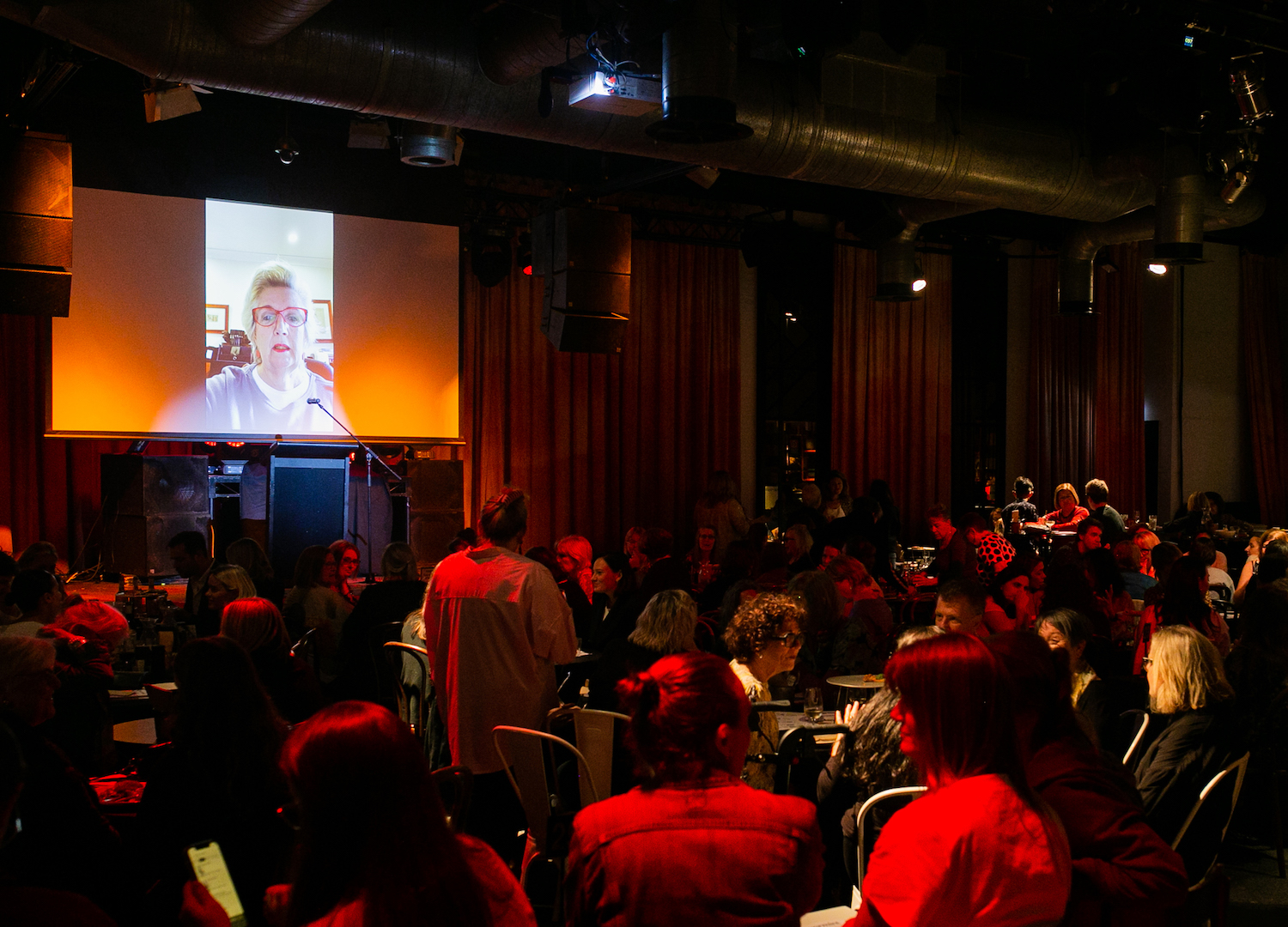
above JANE CARO AM SPEAKING AT GENERATION WOMEN SYDNEY: REVOLUTION! PHOTO BY TENIOLA KOMOLAFE.
Sydney Storyteller Team 60s: Jane Caro AM
When I was a child, I did not fit. I was not sporty or physically brave. I could not run, I could neither throw nor catch a ball. I was relentlessly patronised by all the sporty girls in primary school who tried to ‘help’ improve my skills. How I hated their assumption of superiority. My special dread was when a teacher picked two sporty girls to captain two sides of some hideous game that I had no desire to play and no power to escape. They then picked their team. I was inevitably and humiliatingly the last picked. I still loathe team sports. I do not play them and I do not watch them and whenever anyone – often the parent of some poor, miserable child – tries to tell me that team sports are ‘good’ for kids’ sociability and cooperation, I have a very hard time not laughing in their face. Team sport is fun for those who are good at it – it’s competitive, right? It is purgatory for those who are not.
But I wasn’t a misfit just because I was uncoordinated. I was a voracious reader, happy to spend lunchtimes in the library, not least to avoid the relentless physicality of the playground. I was at least a foot shorter than some of the children I was expected to compete with. Apart from having no hope of winning, I was also often terrified!
As a result of my precocious reading, I also used – oh sin above all sins – “BIG WORDS”! No wonder I had few friends of my own age. The ones I did have were misfits like me and far from being grateful to them and valuing their individuality, I was ashamed of them. I yearned to be part of the cool crowd, not the nerd crowd.
When I finished sixth class at Chatswood Public, I went into first form – as it was called then, now it’s Year 7 – at Forest High. To give you an idea of how small I was in stature, I vividly remember being in my first science class seated at one of those science lab benches on a stool. Our teacher had just finished telling us that when an adult entered the room, we all had to stand. As if on cue (no doubt it was a set-up) the Science Master entered the room. Obediently we all stood. My teacher started glaring in my direction. I assumed she must be looking at someone behind me. Eventually, she said in a very angry voice, “You, yes you, The girl in the front row!” She was pointing at me. “Why aren’t you standing up?”
“I am standing up!” I said, and the whole class howled with laughter. Humiliated again.
I never did grow that much, as you can see, but it was two things that saved me. They are called breasts. I grew boobs. Excellent and quite large boobs. That had an instant and – I confess – very gratifying effect on my status. Suddenly, for the first time ever, I could see I was the object of envy.
If no one can hear your message, who gives a fuck how important or well-expressed it is? I am eternally grateful for that.
By the time I reached second year (Year 8), I decided I had had enough of being a misfit and wanted friends – cool friends. Perhaps the boobs gave me a bit more confidence. Anyway, I set about – quite deliberately – watching the attributes of the cool girls with an eye to emulating them. I noticed they wore their hair long and their skirts short – very short – this was the ’70s after all. I grew my hair and hitched my school tunic up over its belt. I noticed they smoked. I took up smoking. I noticed they swore and talked in ’70s teenage patois – “grouse”, “unreal”, “cool”, “mole” “dickwad”, ‘“dipstick”, “really unreal”. I noticed they flirted with boys. The boobs helped mightily with that. But it was the change in how I talked that took the most work. I dropped the dreaded big words and replaced them with four-letter ones (I remain a lifelong fan of foul language). I stopped trying to sound clever and started trying to sound like everyone else.
I am here to tell you that it worked. Within a short time, I had friends, the cool crowd talked to me, bludged smokes off me – or as I learned to call them, durries – even began asking me to their parties. I started to get into trouble with teachers – for real insolence, not for being short. And wagging sport earned me respect, not derision. I got the first of what was to be many boyfriends. Yes, I was officially boy mad and I liked the chase, more than the capture. I was not at all nice to some of those poor lads. I was also happy. I loved high school about as much as I hated primary school.
Now, you may think this is a cautionary tale and why you should not send a pubescent girl to a bog-standard surfie co-ed public school like Forest High. In which case, in my opinion, you have entirely missed the point. I learned so much from having to take a long, hard look at myself and why I didn’t fit. I learned how to talk with people, not at them. I learned that if you want to get along with people you can’t see yourself as better or smarter than they are. I learned to respect the funny, cynical, sarcastic girls in the cool crowd. I liked their defiance, their refusal to kowtow to authority, and their absolute razor-sharp ability to sniff out hypocrisy and cant and mock it. I realised – and there is now research to back this up – that the girls who got into the most trouble were the prettiest and sexiest ones (my boobs turned me instantly from a goody two shoes to an object of deep suspicion among the teachers, even before I began my behavioural transformation). That recognition helped shape my incipient feminism. And, by learning the importance of telling people things in a way they can hear them, I became a much more useful feminist. And that has been the gift of my life.
I did not “dumb myself down” although that is maybe how it looked from the outside. I smartened myself up. I still read lots of books, I still had lots of ideas and opinions. I just learned how to put them without pissing off the people around me. I realised the absolute truth of the fact that if no one can hear your message, who gives a fuck how important or well-expressed it is? I am eternally grateful for that.
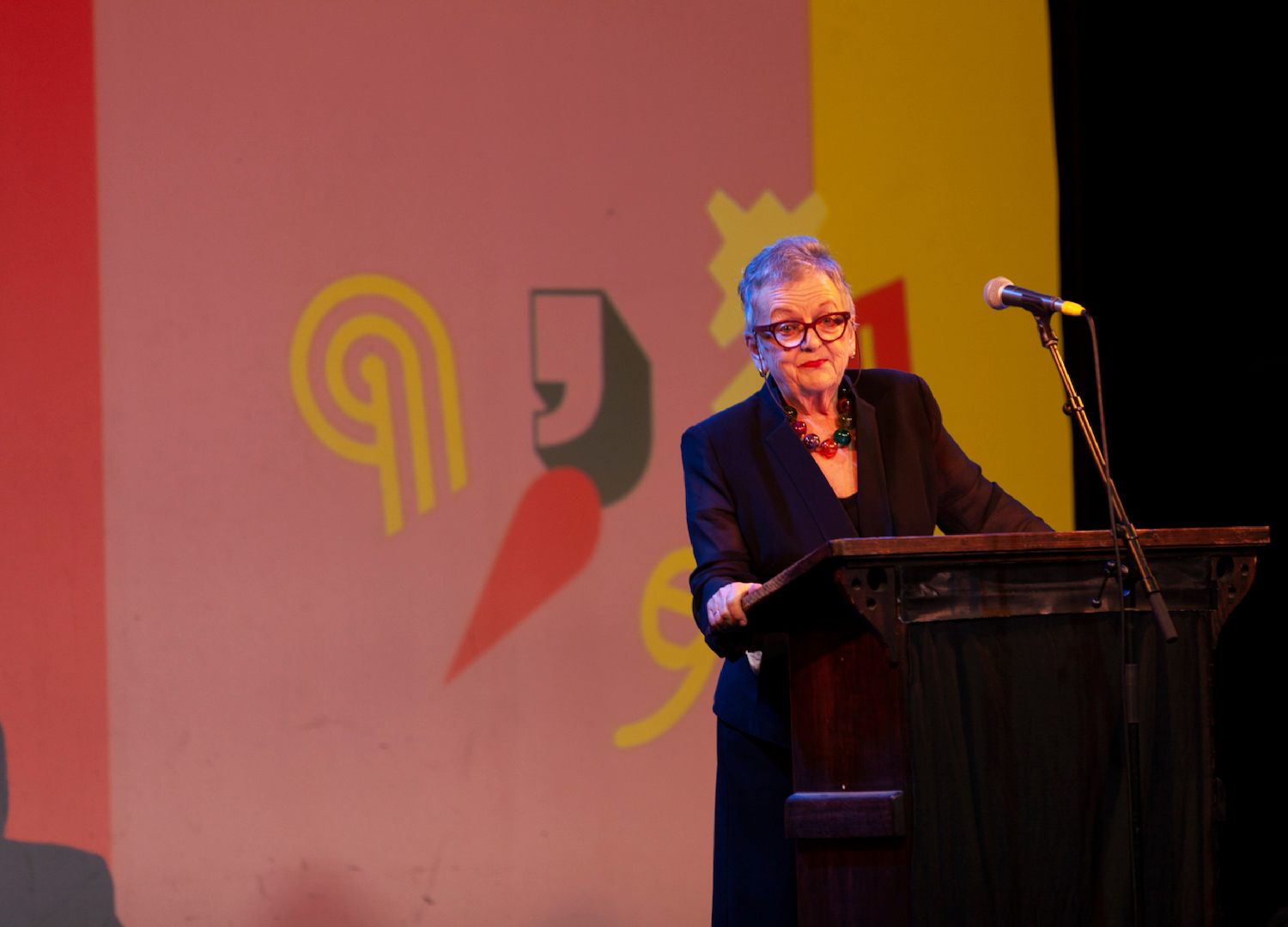
above MOIRA RAYNER SPEAKING AT GENERATION WOMEN MELBOURNE: REVOLUTION! PHOTO BY SEVIM DOGAN OZKAN.
Melbourne Storyteller Team 70s: Moira Rayner
It is a privilege to find work that satisfies your truest passions. Though this year I celebrate exactly 50 years since I was admitted to the bar, it was my calling to work for justice that made me interested when, after years as a barrister and then my appointment as chairman of the Law Reform Commission in WA, I got a call from a headhunter to see if I might be interested in becoming the Commissioner for Equal Opportunity in Victoria.
Be careful what you wish for.
I remained as active a human rights advocate, as a Victorian statutory office holder reporting directly to Parliament, with real authority for receiving complaints and inquiries and promoting the law and procedure on human rights for public and industry’s understanding can, and learned over the first two years of my appointment that no government, Labor or Liberal, Federal or State, likes being held accountable for breaching their own disability, sex and racial discrimination watchdog legislation.
Our office handled all sex race and workplace discrimination human rights complaints under both Victorian and Commonwealth law, and I was the gatekeeper. We had real powers, and very considerable responsibilities, independent of ministers and government departments, who found this inconvenient. We actually answered questions and inquiries live, on the telephone. We visited the whole state to explain what the laws meant and why they were set up in the first place, and how to manage so that they didn’t arise. We fully investigated, reported, held conciliations and explained how to sort things out, and whether a referral to a court was necessary. And I did the referrals or declined to.
My powers were constantly challenged. When the time came, I took a stand, against the legal profession’s and the government’s then-obvious desire to limit the effectiveness of in particular Victorian equal opportunity legislation. After all, I was a lawyer and was appointed for that reason, too.
1992 started out inauspiciously. Well, particularly for me.
My first public line in the sand was my declining the new Premier Kennett’s instruction to reject complaints of indirect race discrimination. He announced the closure of the only school in Australia, internationally recognised, that got Aboriginal and other grossly disadvantaged students to genuinely succeed at this and only this high school and go on to further education. It was a radically different and successful school, and the reasons then given for its demise were not made, in my view, in good faith.
There was general outrage and a major complaint by the students and their parents and the school, to me as commissioner. He had publicly directed that I was not to accept it because it was ‘government policy’. I responded that so was the act and my responsibility to protect it. I referred it to the board, then the independent tribunal, which upheld the complaint after a brilliant application run by one of the parents. He then refused to accept the Equal Opportunity Board’s order to reopen the school, because it was an indirectly racist ‘government policy’ and appealed. Several of the then judges were renowned for not understanding and seeking to minimise the interpretation of the act and decided that the Equal Opportunity Board had misinterpreted the definition and meaning of the act. The two kids took the government to the Supreme Court and eventually won. I cried.
The people made the change. That is what was revolutionary.
The next line in the sand was also risky. I accepted complaints by women prisoners who had been jailed in a maximum security men’s prison near Geelong, because their own prison, Fairlea, was full. It became apparent that Mr Kennett having already started placing women in men’s maximum security prisons, to save money, without considering the effect of being jailed with men and not being able to see their partners and children ‘for their own protection’, was in breach of the sex discrimination legislation.
I conducted a preliminary investigation. It was thorough. I found that such women were directly discriminated against by his ignoring the proof that if he did, women (who didn’t require security except from the blokes) were over-isolated, treated abysmally, would self-harm and many would die in custody. It was already well known that imprisoned women were also likely to self-harm if they were traumatised in their detention, soon after they were released.
I publicly so asserted and called a conciliation, as the act required. The government told me, we won’t change.
Then, I got a tip-off that Kennett had secretly decided to close Fairlea Women’s Prison immediately and move all these women into Pentridge Men’s Prison – called Jika Jika until its wretched condition led to men burning to death, just a few years earlier.
I realised I had to break a convention and suffer the consequences of doing something to stop this. I instructed a senior barrister to help me file an injunction to prevent this from proceeding. He looked hard at me and said nothing. I said I was prepared to lose my job for this.
He quietly prepared the paperwork. I had tried to contact the Attorney General, my minister, who had conscientiously avoided meeting me since she was appointed in 1992, to discuss my office and its resource needs and this kind of policy direction. Unsuccessfully.
So I issued a media release explaining what I was about to do, and why.
The result was massive, positive public support – even all of the media (who were different than they are today) – for the women, the office and the act, but an explosive political outrage from “Jeff “ as he had quickly become known, to my ‘revolutionary’ act, as a ‘public office holder’ in his government.
However, the public response was so huge that Mr Kennett decided not to proceed with this plan. I didn’t have to get an injunction. It was cancelled. The commissioner and the board got a boost in the profile and purpose of equal opportunity laws. The federal sex discrimination commissioner, later to be our first and a great Governor General, supported my decision.
I waited.
On 26 September 1993, my job was declared redundant. I got a tip-off about that from an anonymous source, too. But I was not warned by the Attorney General. An embarrassed little man standing in for that Attorney General rang to tell me, after her own media release went out, claiming it was all for the better administration of the office and after a ‘review’ of the act instigated by her to a committee headed by a Liberal member of the parliament.
I left in a cloud of “glory” and a new reputation in February 1994. Why did it take so long? Because the Victorian Governor deferred, for three months, signing the revocation of my appointment. And what do we take from this?
The act was mauled, immediately. There was no longer to be a commissioner of any kind, but a chief conciliator. There was to be a board she reported to. She no longer had the independence of reporting to the parliament, but reporting to the Attorney General. There was no power to compel parties to participate in conciliation and to provide information for the purposes of an investigation. And the Equal Opportunity Board was also abolished. And those powers have not been restored, and the undermining of a facility that made real changes to the standing of the law of domestic human rights became familiar.
But before that, and for once against the odds, the Victorian Supreme Court in upholding the appeal against the closure of a school, because it required Aboriginal students to comply with a standard of education that had failed them and was available nowhere else, had upheld the principle of unconscious but real indirect discrimination against Aboriginal children, in the Northland Secondary College case, showed the value, for the future, of the people’s response to unfair government action. If the Northland student body and the community it had been founded in had not held witty and persistent protests, run a ‘rebel school’ in school premises or public places, and reminded the people of the importance of the principle of equitable outcomes for disadvantaged students, the judges would not have been able or willing to change the culture of the legal profession that had delighted in its denigration.
The people made the change. That is what was revolutionary.


